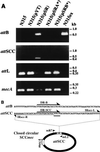A new class of genetic element, staphylococcus cassette chromosome mec, encodes methicillin resistance in Staphylococcus aureus
- PMID: 10817707
- PMCID: PMC89911
- DOI: 10.1128/AAC.44.6.1549-1555.2000
A new class of genetic element, staphylococcus cassette chromosome mec, encodes methicillin resistance in Staphylococcus aureus
Abstract
We have previously shown that the methicillin-resistance gene mecA of Staphylococcus aureus strain N315 is localized within a large (52-kb) DNA cassette (designated the staphylococcal cassette chromosome mec [SCCmec]) inserted in the chromosome. By sequence determination of the entire DNA, we identified two novel genes (designated cassette chromosome recombinase genes [ccrA and ccrB]) encoding polypeptides having a partial homology to recombinases of the invertase/resolvase family. The open reading frames were found to catalyze precise excision of the SCCmec from the methicillin-resistant S. aureus chromosome and site-specific as well as orientation-specific integration of the SCCmec into the S. aureus chromosome when introduced into the cells as a recombinant multicopy plasmid. We propose that SCCmec driven by a novel set of recombinases represents a new family of staphylococcal genomic elements.
Figures






References
-
- Ayliffe G A. The progressive intercontinental spread of methicillin-resistant Staphylococcus aureus. Clin Infect Dis. 1997;24(Suppl. 1):74–79. - PubMed
-
- Barberis-Maino L, Berger-Bachi B, Weber H, Beck W D, Kayser F H. IS431, a staphylococcal insertion sequence-like element related to IS26 from Proteus vulgaris. Gene. 1987;59:107–113. - PubMed
-
- Chambers H F, Neu H C. Penicillins. In: Mandell G, Bennett J E, Dolin R, editors. Principles and practice of infectious diseases. New York, N.Y: Churchill Livingstone; 1995. pp. 233–246.
-
- Clewell D B. Conjugative transposons. In: de Bruijn F J, Lupski J R, Weinstock G M, editors. Bacterial genomes. New York, N.Y: Chapman and Hall; 1998. pp. 130–139.
Publication types
MeSH terms
Substances
Associated data
- Actions
LinkOut - more resources
Full Text Sources
Other Literature Sources

